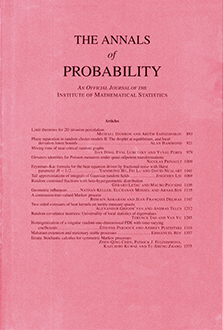Abstract
Let $\mathscr{T}_{n}(x)$ denote the time of first visit of a point x on the lattice torus ℤn2=ℤ2/nℤ2 by the simple random walk. The size of the set of α, n-late points $ℒ_{n}(\alpha )=\{x\in \mathbb {Z}_{n}^{2}: \mathscr{T}_{n}(x)\geq \alpha \frac{4}{\pi}(n\log n)^{2}\}$ is approximately n2(1−α), for α∈(0,1) [ℒn(α) is empty if α>1 and n is large enough]. These sets have interesting clustering and fractal properties: we show that for β∈(0,1), a disc of radius nβ centered at nonrandom x typically contains about n2β(1−α/β2) points from ℒn(α) (and is empty if $\beta <\sqrt{ \alpha }$), whereas choosing the center x of the disc uniformly in ℒn(α) boosts the typical number of α,n-late points in it to n2β(1−α). We also estimate the typical number of pairs of α, n-late points within distance nβ of each other; this typical number can be significantly smaller than the expected number of such pairs, calculated by Brummelhuis and Hilhorst [Phys. A 176 (1991) 387–408]. On the other hand, our results show that the number of ordered pairs of late points within distance nβ of each other is larger than what one might predict by multiplying the total number of late points, by the number of late points in a disc of radius nβ centered at a typical late point.
Citation
Amir Dembo. Yuval Peres. Jay Rosen. Ofer Zeitouni. "Late points for random walks in two dimensions." Ann. Probab. 34 (1) 219 - 263, January 2006. https://doi.org/10.1214/009117905000000387
Information





